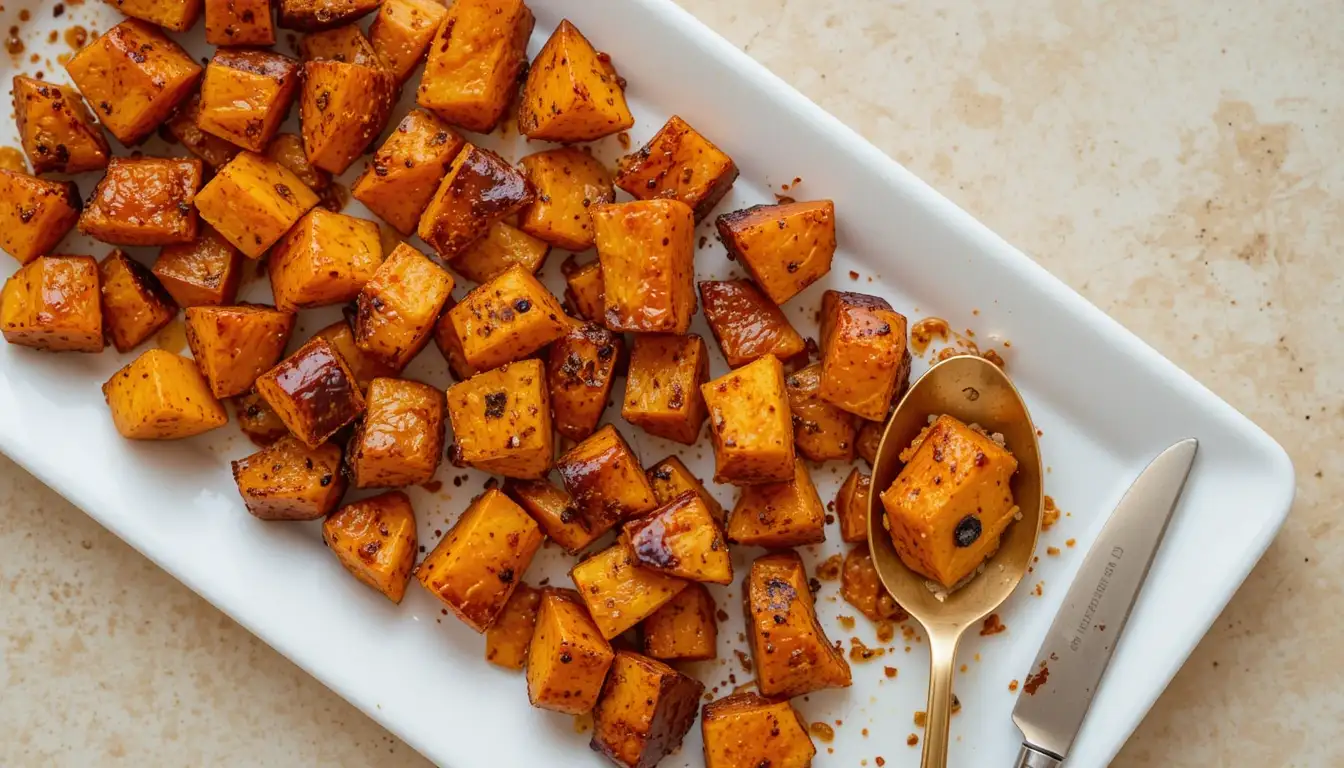I remember the first time I truly connected with the food I was preparing. It wasn’t during a complex meal, but a quiet afternoon in my kitchen, the golden autumn light streaming through the window. I cradled the unassuming butternut squash, appreciating its firm feel and smooth exterior. As I carefully prepared it, peeling away the tough exterior to reveal the vibrant orange flesh, a sense of calm washed over me.
The simple, rhythmic motions of chopping, the light scent filling the air – it felt grounding. That day, I wasn’t just making food; I was engaging in a mindful practice. The resulting roasted butternut squash, tender and naturally sweet, wasn’t just delicious. It felt deeply nourishing, pure, and clarifying. This simple recipe captures that essence. It offers a straightforward path to a wonderfully satisfying dish, aligning beautifully with a peaceful, balanced state of mind. It’s more than just a recipe for roasting; it’s an invitation to find joy in simplicity. We will learn how to roast this beautiful vegetable perfectly.
Table of Contents
Common Questions
Before we delve into the preparation, let’s address some common questions people have about this lovely winter squash. Understanding the basics helps appreciate the process and the wonderful result.
How do you roast a butternut squash?
- Roasting butternut squash is fundamentally simple. The core process involves cutting the squash, removing the seeds, seasoning it lightly, and baking it in a moderately hot oven. You bake until it becomes tender and slightly caramelized. Typically, you can roast it in halves or cube it.
- For this easy recipe, we will focus on how to roast butternut squash cubes. These cook relatively quickly and are wonderfully versatile. The basic steps are: prepare the squash (peel, seed, cube), toss with a little oil (like ghee or coconut oil) and sattvic seasonings. Distribute the pieces across a baking sheet, then place in the oven to cook until they reach a soft consistency. We’ll cover the specifics in detail below, showing you how to make roasted butternut squash perfectly.
Is roasted butternut squash healthy?
- From a sattvic perspective, roasted butternut squash is considered very beneficial. It’s naturally sweet, grounding, and easy to digest when prepared correctly. The squash’s deep orange hue is a visual cue for its beta-carotene, content, a nutrient the body transforms into Vitamin A, essential for maintaining healthy vision and supporting the immune system. Furthermore, it offers Vitamin C, potassium, and dietary fiber.
- When prepared simply – without heavy spices, onions, or garlic – it supports clarity and calmness. Roasting enhances its natural sweetness without needing excessive fats or overpowering flavors. It’s a nourishing food providing energy without causing heaviness or agitation. This makes it a wonderful addition to a balanced diet and one of the best squash recipes.
What does roast butternut squash taste like?
- Roasted butternut squash has a unique and delightful flavor profile. Roasting concentrates its natural sugars. This results in a taste that is subtly sweet, almost nutty, and deeply comforting. The texture becomes incredibly tender, soft, and almost creamy when properly roasted.
- The edges might become slightly caramelized, adding a hint of deeper, richer flavor. You’ll notice a beautiful golden brown hue. Unlike raw squash, the roasted flavor is mellow, smooth, and very pleasant. It lacks bitterness and has an inherent warmth perfect for cooler seasons. Its gentle nature makes it welcome year-round in a sattvic diet.
Why do people like butternut squash?
- People love butternut squash for many reasons! Its natural sweetness is a big draw, offering comfort without refined sugars. Its versatility is incredible. It shines as a simple side dish, transforms into creamy butternut squash soup, elevates a salad, and complements grains beautifully. The smooth texture after cooking is also very appealing.
- Furthermore, its nutritional profile makes it a wholesome choice. From a practical standpoint, it stores well, making it a reliable staple. And let’s be honest, that beautiful bright orange color just makes any dish look more inviting! Its comforting qualities align well with the desire for wholesome food. Learning how to cook butternut squash opens up many delicious possibilities.
Choosing Your Ingredients for the Best Flavor
The beauty of sattvic cooking lies in purity and freshness. Starting with high-quality ingredients is paramount. This ensures the best taste and the most positive energetic qualities in your roasted butternut squash.

- The Butternut Squash: Look for a squash that feels heavy for its size – this indicates good moisture content. The skin should be firm, smooth, and matte, without soft spots or deep cuts. A deep, uniform beige color is ideal. Ensure a small section of the stem is still connected at the top. Choose a whole butternut squash if possible for better freshness. Selecting a good squash is the first step to a great recipe.
- The Cooking Fat:
- Ghee (Clarified Butter): holds a place of preference as a cooking medium within both Ayurveda and sattvic food principles. Its ability to withstand high heat without degrading, combined with its delightful nutty essence, earns it high regard as a sattvic ingredient. It promotes digestion and calmness. A little goes a long way.
- Coconut Oil: A good vegan alternative. Choose virgin, unrefined coconut oil. It has a pleasant, mild flavor suitable for roasting temperatures. Ensure it’s fresh.
- High-Quality Olive Oil (Use with Awareness): While less traditional than ghee, quality cold-pressed olive oil can be used sparingly, perhaps for finishing. Be mindful of its lower smoke point. For this roasted butternut squash recipe, ghee or coconut oil is best for roasting. We need just enough for a light coat on the squash cubes. A gentle drizzle works well.
- The Salt: Use pure, unrefined salt like Himalayan pink salt or sea salt. Avoid iodized table salt. Salt enhances the natural sweetness of the squash.
- Optional Sattvic Seasonings (See Section 6): Fresh herbs like sage (mildly), or warming spices like cinnamon, ginger, or nutmeg. Quality matters – use fresh or recently purchased dried spices.
Remember, the goal is to enhance the squash’s natural goodness, not overpower it. Simplicity is key when you roast this vegetable.
Preparing Your Roasted Butternut Squash: Step-by-Step Guide
Preparing a butternut squash might seem challenging due to its tough skin. However, with the right technique, it becomes a manageable and mindful process. We’ll now detail a secure and streamlined technique for preparing a butternut squash. Patience ensures uniform squash cubes for even roasting.

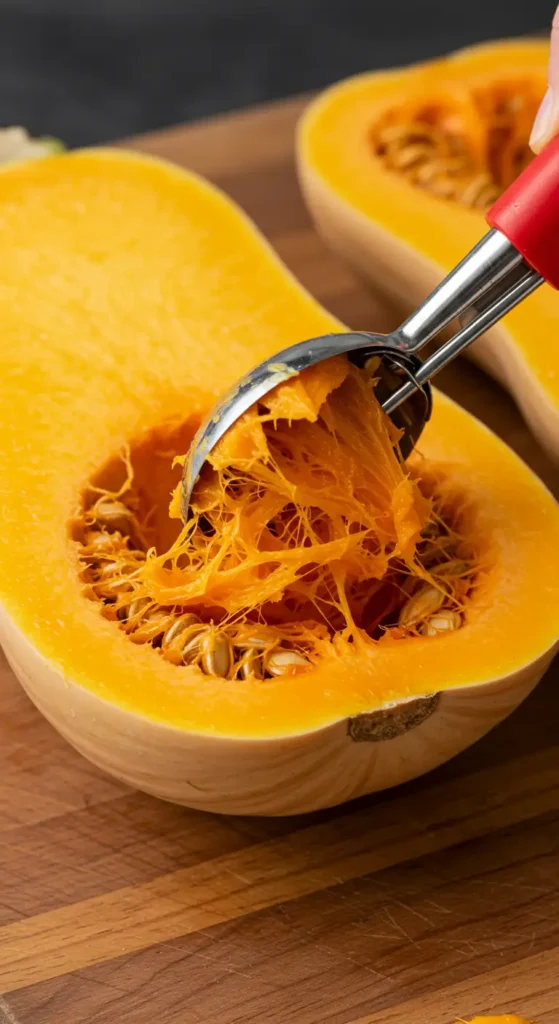
Step 1: Wash and Dry
- Thoroughly wash the outside of the squash. Use a brush if needed. Use a fresh cloth to thoroughly wipe away all moisture from the squash’s surface. A dry surface prevents slipping, crucial for safety.
Step 2: Trim the Ends
- Place the squash horizontally on a sturdy cutting board. Use a large, sharp chef’s knife to carefully trim about half an inch from both ends. This creates flat, stable surfaces.
Step 3: Separate the Neck and Bulb
- Stand the squash upright on its wider cut end. Carefully slice the squash down the middle, separating the long neck from the round bulb where seeds reside. Alternatively, cut the squash horizontally first where the neck meets the bulb. Choose what feels most stable
Step 4: Peel the Squash
- Now, peel the squash. A sharp Y-shaped vegetable peeler often works best on the tough squash skin. Stand the neck piece on end and peel downwards. For the bulb, place it cut-side down for stability and peel the curve. Make sure to strip off the entire outer rind, including the lighter green flesh found just beneath it. Employing a vegetable peeler for this task is advisable for safety over using a knife. Peel butternut squash completely.
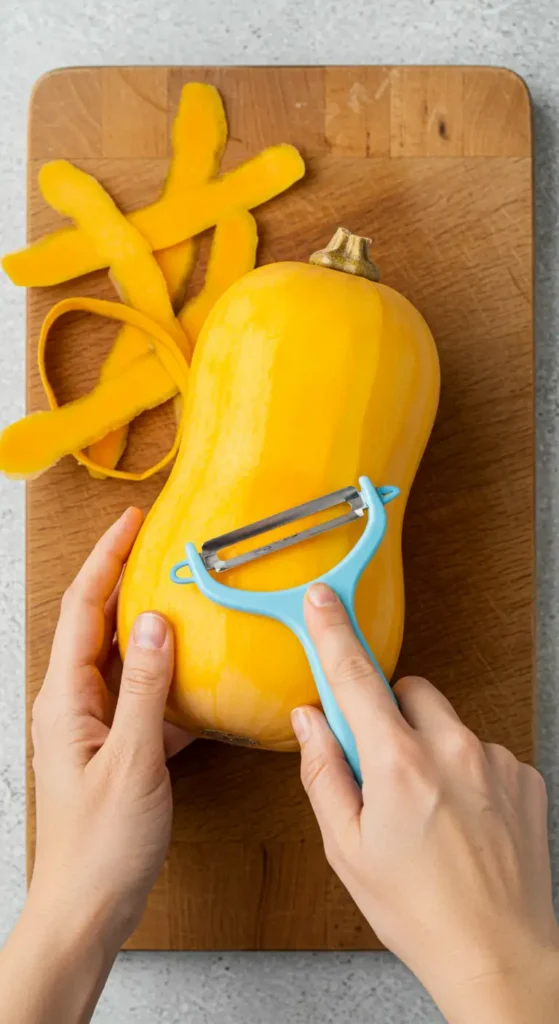
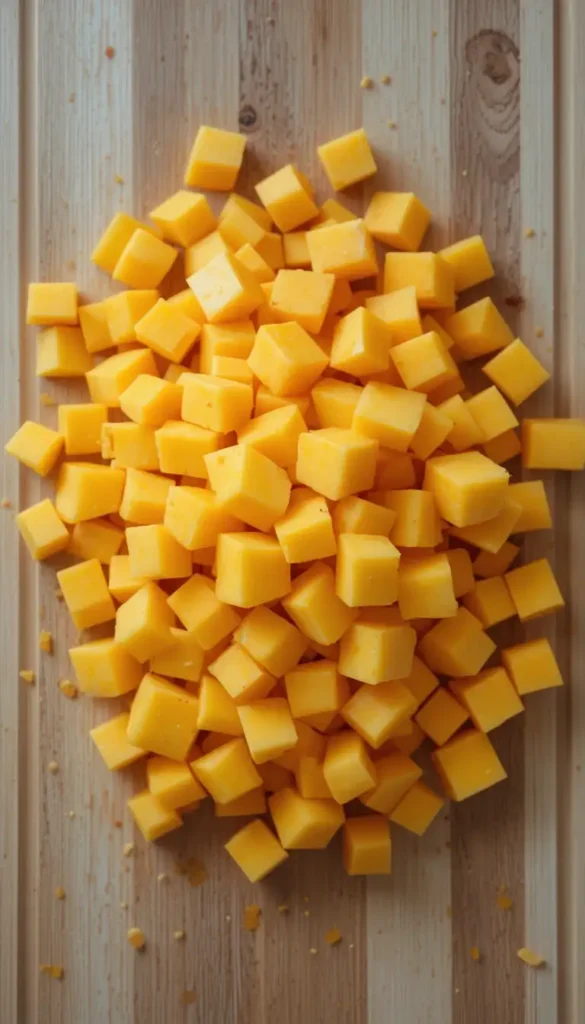
Step 5: Cut the Bulb and Scoop Out Seeds
- Cut the squash in half – specifically the bulbous part, vertically. You’ll see the cavity with squash seeds and stringy bits. Employ a robust spoon to meticulously clear out the inner cavity, removing all seeds and connected fibrous strands. Scoop everything out. You can discard these or save the butternut squash seeds to roast separately later for a snack. Ensure you remove all seeds and stringy parts.
Step 6: Cube the Squash
- Now it’s time to cube the squash. Lay the peeled neck flat. Cut into 1-inch thick planks, then 1-inch wide strips, then 1-inch cubes. Address the rounded bottom sections by first cutting them into slices approximately one inch across, and subsequently dicing these slices into one-inch pieces. Aim for uniform squash pieces. You should now have a bowl of beautiful butternut squash cubes. This process helps cut butternut squash safely. You have prepared your squash in cubes.
Take your time with this preparation. Working mindfully infuses the food with positive intention. You now know how to prepare butternut squash before roasting.
The Roasting Process: Achieving Golden Perfection
This is where the magic happens! Roasting transforms the firm cubed butternut squash into tender, sweet morsels. We aim for that perfect texture – soft inside, slightly caramelized outside. Achieving a beautiful golden brown color is key when you bake butternut squash cubes.
- Preheat Your Oven: Set your oven to 400 degrees F (200 degrees C). Allow it adequate time to fully preheat. A hot oven helps the squash cook quickly, developing flavor properly. Set the oven to 400 degrees.
- Prepare the Baking Sheet: Choose a large, rimmed baking sheet. Lining with parchment paper helps cleanup, but isn’t essential if oiled lightly.
- Season the Squash: Place the butternut squash cubes in a large bowl. Lightly coat the squash pieces using approximately one to two tablespoons of liquefied ghee or coconut oil for each whole squash prepared. Coat lightly, avoiding greasiness. Add a pinch of pure rock salt. Add optional seasoning now (see next section).
- Toss to Coat: Gently toss the squash cubes in the bowl. Use hands or a large spoon. Ensure each cube is lightly coated with oil and seasonings for even roasting and to prevent sticking.
- Transferring to the Pan: Distribute the coated squash cubes evenly across the readied baking tray. Arrange them in a single layer. This is crucial! Do not overcrowd the pan, or they will steam instead of roast. Use two baking sheets if needed. Place the squash carefully.
- Roast: Insert the tray holding the squash into the fully heated oven. Allow it to cook for roughly 20 to 30 minutes. Time varies by cube size and oven.
- Check for Doneness: After 20 minutes, check the squash. Check for doneness by inserting a fork; the flesh should yield easily. Edges should be lightly brown and caramelized. If not tender, roast 5-10 minutes more, checking often. You want the squash is tender, not mushy. Cook butternut squash until perfect.
- Remove and Serve: Once roasted butternut squash is tender and lightly golden brown, carefully remove from the oven. Your easy roasted butternut squash is ready! This is how you roast the squash.
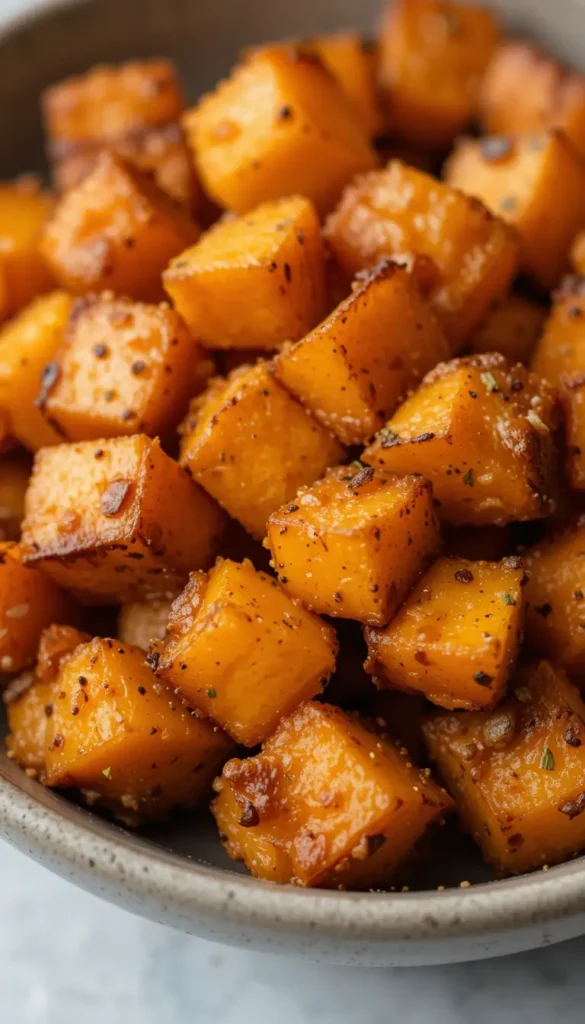
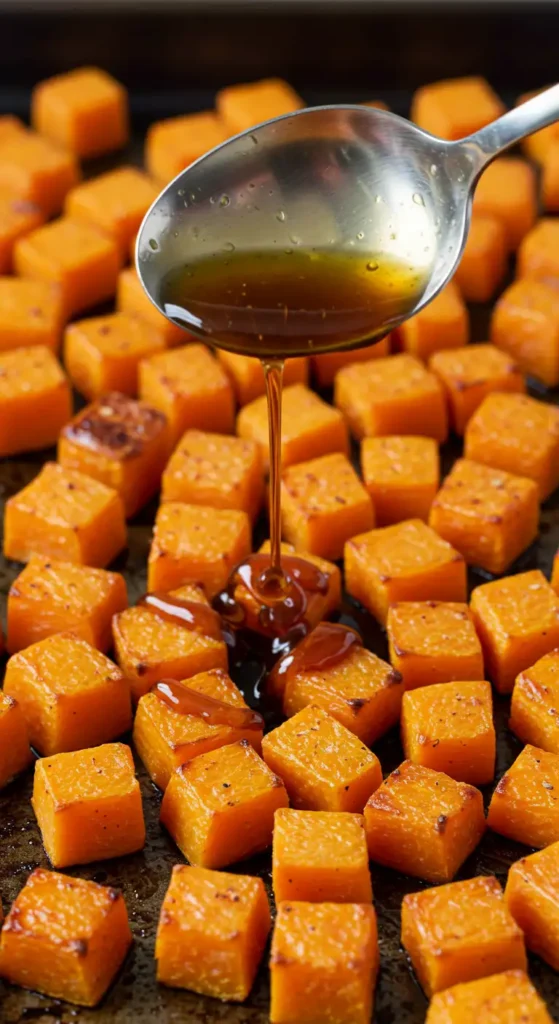
Following this straightforward method enables the squash’s inherent sugary notes to become beautifully pronounced. The oven heat transforms the humble cube into a delicious treat.
Simple Flavor Enhancements You’ll Love
Enjoyed simply with just ghee or oil and a touch of salt, roasted butternut squash possesses a delightful purity of flavor. However, a few simple, sattvic additions can elevate the flavor without creating imbalance. Here are gentle ways to enhance your squash:
- Warming Spices: Sprinkle spices to complement the sweetness.
- Cinnamon & Ginger: Use 1/4 to 1/2 tsp cinnamon and a pinch of ginger tossed with squash cubes before roasting. The result is a batch of roasted butternut squash infused with the delightful warmth of cinnamon.
- Nutmeg: Introducing a very small amount of the freshly grated spice lends a comforting, warm fragrance.
- Mild Herbs (Use Judiciously): Mild use of certain fresh herbs can add brightness.
- Sage: A few fresh leaves added to the baking sheet during the last 10 minutes of roasting impart subtle fragrance. Remove before serving if desired.
- Rosemary: A very small sprig added during the last few minutes. Use cautiously due to strong flavor.
- Fresh Parsley or Cilantro: Toss roasted butternut squash with chopped fresh parsley or cilantro after roasting for freshness.
- A Touch of Natural Sweetness:
- Pure Maple Syrup: For maple roasted butternut squash, add a tiny drizzle of pure maple syrup during the last 5-10 minutes of roasting. Carefully combine the squash with one to two teaspoons of maple syrup, then briefly reintroduce the pan to the oven. This enhances caramelization.
- Jaggery (Gur): A tiny amount of grated jaggery added near the end, melting to glaze the squash, is another sattvic option.
- Simple Savory: For a purely savory note beyond salt, a tiny pinch of black pepper can be used minimally.
Remember, the goal is gentle enhancement using thoughtful seasoning. Toss the squash lightly. Start small; you can add more fresh herb after tasting. These additions make the roasted flavor even more delightful.
How to Enjoy Your Roasted Butternut Squash: Serving Ideas
Now that you have perfectly roasted butternut squash, tender and sweet, how can you enjoy it? Its versatility is a great strength, fitting beautifully into many sattvic meals.
- As a Simple Side Dish: Serve warm roasted butternut squash cubes alongside simple grains like quinoa or rice, and perhaps steamed greens or dal. It makes a truly delicious side dish complementing most mains. It’s a fantastic delicious side. This is one of the classic fall recipes.
- In Salads: Cool the roasted butternut squash slightly, then add to your favorite salad. It pairs wonderfully with tender greens, toasted nuts/seeds, a light vinaigrette, and maybe paneer or chickpeas. Including roasted butternut squash in a salad recipe lends both satisfying weight and attractive visual vibrancy.
- Added to Grain Bowls: Layer cooked grains with roasted butternut squash, steamed vegetables (roasted veggies like sattvic roasted brussels sprouts work too), legumes, and a simple dressing or yogurt.
- Base for Soup: Transform cooked butternut cubes into a light butternut squash soup. Blend the roasted squash with warm water or light broth, ginger or cinnamon if desired, and coconut milk/cream. Adjust seasoning. This method yields a rapidly prepared roasted butternut squash soup, which can easily be made suitable for a vegan diet.
- With Pasta or Noodles: Gently toss warm roasted butternut squash with simple pasta or rice noodles, ghee/oil, fresh herbs (parsley/sage), and maybe toasted nuts.
- As Mashed Butternut Squash: Easily mash the tender roasted butternut squash with a fork, adding ghee and salt. This mashed butternut squash is a lovely alternative to mashed potatoes.
Once prepared by roasting, butternut squash emerges as a wonderfully flavorful component adaptable to a wide array of culinary applications. Its gentle sweetness makes it welcome in many meals. Use roasted squash creatively!
Pro Tips for Storage
Proper storage ensures you enjoy your delicious roasted butternut squash for days. Here are tips and answers to common questions:
- Storing Leftovers: Cool the roasted butternut squash completely. Transfer squash pieces to an airtight container. Refrigerate for 3-4 days. Storing squash in an airtight container maintains freshness.
- Reheating: Enjoy cold or reheat gently.
- Oven: Warm on a baking sheet at 350°F (175°C) for 5-10 minutes. This preserves texture best.
- Stovetop: Warm gently in a skillet over medium-low heat with a little ghee/oil.
- Microwave (Use Mindfully): Less preferred in sattvic practice as it can alter energy and texture. If necessary, use short bursts on medium. We mention the microwave but recommend other methods.
We hope these tips help you confidently cook butternut squash. Enjoy this recipe – it’s an easy and delicious, simple recipe. Truly a great recipe for those who love butternut squash.
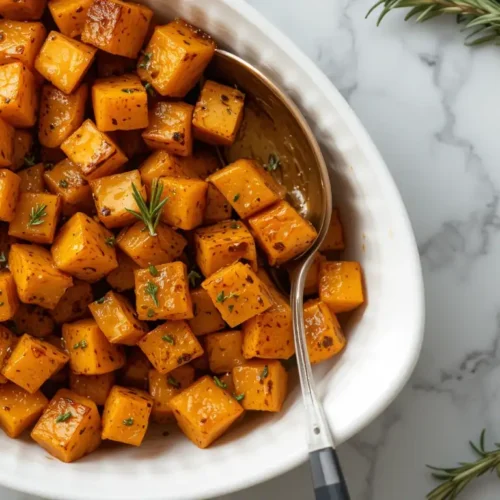
Roasted butternut squash
Ingredients
- The Butternut Squash:
- Look for a squash that feels heavy for its size – this indicates good moisture content. The skin should be firm smooth, and matte, without soft spots or deep cuts. A deep, uniform beige color is ideal. A piece of the stem should still be attached. Choose a whole butternut squash if possible for better freshness. Selecting a good squash is the first step to a great recipe.
- The Cooking Fat:
- Ghee Clarified Butter: This is the preferred cooking fat in Ayurveda and sattvic cooking. Ghee has a high smoke point, a lovely nutty flavor, and is considered highly sattvic. It promotes digestion and calmness. A little goes a long way.
- Coconut Oil: A good vegan alternative. Choose virgin unrefined coconut oil. It has a pleasant, mild flavor suitable for roasting temperatures. Ensure it’s fresh.
- High-Quality Olive Oil Use with Awareness: While less traditional than ghee, quality cold-pressed olive oil can be used sparingly, perhaps for finishing. Be mindful of its lower smoke point. For this roasted butternut squash recipe, ghee or coconut oil is best for roasting. We need just enough for a light coat on the squash cubes. A gentle drizzle works well.
- The Salt:
- Use pure unrefined salt like Himalayan pink salt or sea salt. Avoid iodized table salt. Salt enhances the natural sweetness of the squash.
Optional Sattvic Seasonings (See Section 6):
- Fresh herbs like sage mildly, or warming spices like cinnamon, ginger, or nutmeg. Quality matters – use fresh or recently purchased dried spices.
Instructions
Step 1: Wash and Dry
- Thoroughly wash the outside of the squash. Use a brush if needed. Pat it completely dry with a clean towel. A dry surface prevents slipping, crucial for safety.
Step 2: Trim the Ends
- Place the squash horizontally on a sturdy cutting board. Use a large, sharp chef’s knife to carefully trim about half an inch from both ends. This creates flat, stable surfaces.
Step 3: Separate the Neck and Bulb
- Stand the squash upright on its wider cut end. Carefully slice the squash down the middle, separating the long neck from the round bulb where seeds reside. Alternatively, cut the squash horizontally first where the neck meets the bulb. Choose what feels most stable
Step 4: Peel the Squash
- Now, peel the squash. A sharp Y-shaped vegetable peeler often works best on the tough squash skin. Stand the neck piece on end and peel downwards. For the bulb, place it cut-side down for stability and peel the curve. Remove all skin and the pale green layer underneath. Using a peeler is safer than a knife here. Peel butternut squash completely.
Step 5: Cut the Bulb and Scoop Out Seeds
- Cut the squash in half – specifically the bulbous part, vertically. You’ll see the cavity with squash seeds and stringy bits. Use a sturdy spoon to scoop out the seeds and membranes cleanly. Scoop everything out. You can discard these or save the butternut squash seeds to roast separately later for a snack. Ensure you remove all seeds and stringy parts.
Step 6: Cube the Squash
- Now it’s time to cube the squash. Lay the peeled neck flat. Cut into 1-inch thick planks, then 1-inch wide strips, then 1-inch cubes. For the bulb halves, cut into 1-inch wide slices, then into 1-inch cubes. Aim for uniform squash pieces. You should now have a bowl of beautiful butternut squash cubes. This process helps cut butternut squash safely. You have prepared your squash in cubes.
Notes
- Fat: 8-12g (mostly from ghee/coconut oil)
- Protein: 2-3g
- Carbohydrates: 25-30g
- Fiber: 4-6g
- Vitamin A: High (from beta-carotene)
- Vitamin C: Moderate
- Potassium: Moderate
Tried it? Let’s Chat Below!
You’ve journeyed through the simple, mindful process of creating wonderfully tender and sweet roasted butternut squash. From selecting the perfect squash to achieving that lovely golden brown roast, we hope you found joy in this easy to follow guide.
Now, we’d love to hear from you!
- Did you make this recipe?
- What are your favorite ways to enjoy roasted butternut squash? Did you add it to a salad or make butternut squash soup?
- Did you try any of the flavor variations, like the cinnamon roasted butternut squash or the maple roasted butternut squash?
- Do you have any questions or tips of your own to share?
Please leave a comment below, rate the recipe, and share your experience. Your feedback helps others and builds our community around wholesome, nourishing food. We truly hope you enjoy this recipe! Let’s continue to explore the simple delights of sattvic cooking together.

